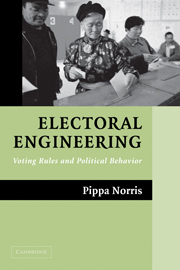11 - The Impact of Electoral Engineering
Published online by Cambridge University Press: 05 September 2012
Summary
The starting point for this book was the observation that during the last decade issues of electoral engineering have arisen on the policy agenda in many countries. Major reforms in established democracies have challenged the notion that electoral systems are necessarily stable institutions. In most Western democracies, once the great debate about the universal franchise was resolved and the mass party system consolidated, electoral systems seemed, for the most part, settled and enduring features of the constitutional landscape. Lijphart's study of the electoral systems used in twenty-seven established democracies from 1945 to 1990 found that only one (France) had experienced a fundamental change from plurality to PR, or vice versa. Furthermore, Bartolini and Mair noted only 14 unbroken transitions in Europe between 1885 and 1985, meaning a major shift in electoral rules between two democratic elections, excluding disruptions caused by wars, dictatorships, the establishment of a new state, or the reappearance of an old one. In Western countries the electoral rules of the game, within which political scientists could get on with analyzing individual-level voting behavior, appeared settled and predictable. No longer. In the 1990s some established democracies experienced the most radical reforms to electoral systems in over a century. Major changes from majoritarian to PR, or vice versa, have occurred in 5 of the 21 countries originally identified by Lijphart in the mid-1970s as established postwar democracies (Israel, Japan, New Zealand, Britain, and Italy), and more modest amendments also have been adopted in Austria, Portugal, and Switzerland.
- Type
- Chapter
- Information
- Electoral EngineeringVoting Rules and Political Behavior, pp. 249 - 264Publisher: Cambridge University PressPrint publication year: 2004

